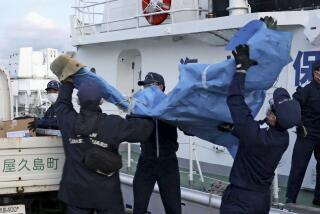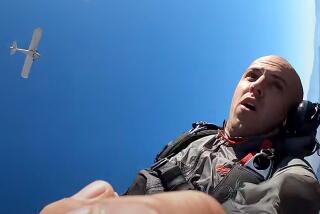Robert M. White dies at 85; pilot made history with 1962 test flight into space
Robert M. White was a 38-year-old U.S. Air Force major and record-setting test pilot at Edwards Air Force Base in 1962 when he joined the elite ranks of America’s four astronauts.
But Mercury astronauts Alan Shepard, Virgil Grissom, John Glenn and Scott Carpenter went into space seated atop ballistic missiles and returned in capsules that parachuted onto the ocean.
White did it as the pilot of a rocket-powered X-15 research airplane, flying nearly 60 miles above the Earth’s surface and completing a conventional landing on Rogers Dry Lake at Edwards Air Force Base.
His out-of-this-world adventure earned him the distinction of being the first man to earn a winged astronaut rating by piloting an airplane in space.
White, a retired Air Force major general who also was a decorated veteran of World War II and the Korean and Vietnam wars, died of age-related causes in his sleep March 17 at an assisted-living facility in Orlando, Fla., said his son, Greg. He was 85.
“He lived his whole life, it seems, on the edge of danger, and he died so peacefully,” said Greg White.
Jim Young, chief historian at the Air Force Flight Test Center at Edwards Air Force Base, said White was “one of the major icons in aerospace history.”
“It’s been so many years since his achievements,” Young said, “but they were extraordinary and remain extraordinary to this day.”
A 1954 graduate of what is now the U.S. Air Force Test Pilot School at Edwards Air Force Base, White became the first lead Air Force project pilot for the X-15 flight research program that was launched by NASA, the Air Force and the Navy. The first flight was in 1958.
During an eight-month span in 1961, White achieved three milestones.
On March 7, 1961, he became the first pilot to exceed Mach 4, attaining a top speed of 2,905 mph.
On June 23, 1961, he became the first pilot to exceed Mach 5, recording a speed of 3,603 mph.
And on Nov. 9, 1961, during the first full-throttle flight of the X-15, he became the first pilot to exceed Mach 6, attaining a top speed of 4,094 mph.
Then, on July 17, 1962, White flew the X-15 to an altitude of 314,750 feet -- 59.6 miles above Earth.
“This is a fantastic view,” he reportedly radioed while flying weightless.
He said after landing that it was too cloudy to see the ocean, “but I could see the coastline of the Western United States from well above San Francisco Bay down into Mexico.”
Calling him “the nation’s newest space hero,” Life magazine featured a photo of White on its cover greeting son Greg, then 7, after the flight. Said the headline: “Boy, That Was a Ride.”
At a 1962 ceremony on the White House South Lawn, President Kennedy presented what had been called the nation’s most treasured aviation award, the Robert J. Collier Trophy, to White and three fellow X-15 pilots.
The X-15 was the forerunner of the space shuttle, whose first orbital flight was in 1981.
“They were flying during a remarkable period in the history of flight,” Young said of the X-15 pilots. “When Chuck Yeager broke the sound barrier at Mach 1 in the Bell X-1 [in 1947], he flew at about 700 miles per hour.
“Just over 14 years later, Bob White is flying at Mach 6 and just over 4,000 miles per hour. It was an extraordinary time at Edwards Air Force Base,” Young said.
In his book “The Right Stuff,” Tom Wolfe described the handsome, nondrinking, churchgoing White as “the eternally correct and reserved Air Force blue-suiter.”
Young said White “was quiet and unassuming, and a very thoughtful guy. He never let the press clippings and all the attention go to his head.”
Born July 6, 1924, in New York City, White became an Army Air Forces cadet in 1942 and was commissioned as a second lieutenant.
He served with the 355th Fighter Group in Europe, where he was shot down over Germany in 1945 and became a prisoner of war.
During the Korean War, he served as a fighter pilot and flight commander with the 40th Fighter Squadron based in Japan.
And during the Vietnam War, he flew 70 combat missions over North Vietnam and received the Air Force Cross for leading a 1967 strike on the heavily defended Paul Doumer Bridge in Hanoi.
White earned a bachelor’s degree in electrical engineering from New York University in 1951 and a master’s in business administration from George Washington University in 1966.
His various assignments included serving as commander of the Air Force Flight Test Center at Edwards in the early 1970s.
White’s second wife, Chris, died in 2007.
In addition to his son Greg, he is survived by his other children from his first marriage, Dennis, Pamela White and Maureen McFillin; his brother, Albert; and four grandchildren.
He will be buried at Arlington National Cemetery.
More to Read
Start your day right
Sign up for Essential California for the L.A. Times biggest news, features and recommendations in your inbox six days a week.
You may occasionally receive promotional content from the Los Angeles Times.






